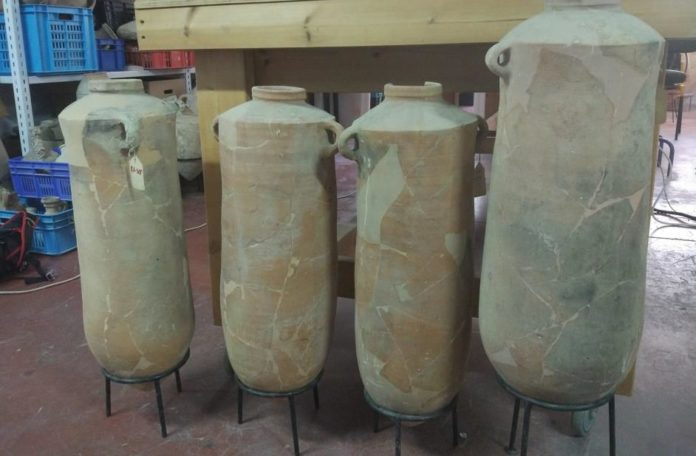By TPS • 1 July, 2019
An ancient facility for the production of the prestigious purple-dyed textiles dating to the Biblical period has been uncovered at Tel Shikmona south of Haifa, the University of Haifa revealed on Monday.
Archeological findings uncovered at Tel Shikmona in the 1960s and 1970s and which have been recently studied revealed the magnificent finding.
“Until now, there has not been any meaningful direct archeological evidence of workshops for the production of purple-colored textiles from the Iron Age – the Biblical period – not even in Tyre and Sidon [in modern-day Lebanon], which were the main Phoenician centers for the manufacture of purple dye. If we have identified our findings correctly, Tel Shikmona on the Carmel Coast has just become one of the most unique archeological sites in the region,” explained Prof. Ayelet Gilboa and PhD candidate Golan Shalvi from the University of Haifa, who are studying the finds that have been held in various storerooms in Haifa for the last half-century.
Tel Shikmona is situated on a small coastal headland on the southern outskirts of Haifa. The site is known mainly for its surrounding Byzantine settlement, including splendid mosaics. The Iron Age settlement dates back to the 11th to 6th centuries BCE, corresponding in Biblical terms to the period of the Judges, the United Monarchy of the Kings Shaul, David, and Shlomo, the later Kingdoms of Israel and Judah and the Assyrian and Babylonian epoch.
The site occupies just about five dunams, a bit more than one acre, out of the 100-dunams of the Byzantine city at its peak.
A section of the tell was excavated thoroughly between 1963-1977 by Dr. Yosef Elgavis on behalf of the Haifa Museum. The site was known by archeologists and experts to have yielded rich material findings. For various reasons, however, these have never been published in a comprehensive manner.
The fact that the archeological finds has never been thoroughly examined spread an aura of mystery over the small biblical settlement. Archeologists could not entirely understand why the settlement was established on the small promontory since the rocky coastline in this area would not have allowed boats to dock safely. Extensive agricultural land is not available around Shikmona so that agriculture too could not have been the purpose of this settlement. Similarly, the site does not lie on any major thoroughfare.
Gilboa and Shalvi found that the findings from the site included the largest collection of ceramic vats found anywhere in the world from the first millennium BCE that still preserve purple coloring of various shades.
Some of the vats have already been analyzed and revealed that the pigments absorbed in clay were genuine sea snails pigments. The scope of the phenomenon, however, has not been realized then. A new chemical examination of dozens of such vats proved that on all the items the stains are indeed true purple coloring extracted from marine snails.
“It is very rare to find shards from this period featuring a purple color. Such items have been found in other sites along Israel’s northern coast, such as Dor and Akko, but in small numbers. Yet at Shikmona there are almost 30 vessels of this type. This is very unusual,” the researchers emphasized.
In addition to the production of the dye, dozens of spindle whorls and loom weights were also found, testifying to the manufacture of wool and textiles that were dyed on site.
Purple coloring was produced in Biblical times and was used to dye the most prestigious clothes. The famous purple, argaman and techelet in Hebrew, was produced from the glands of maritime snails of the Murex family. Since thousands of snails were needed in order to produce a single kilogram of dye, wearing purple clothes became the privilege of nobility and royalty and a sign for dominion and power. In many kingdoms, ordinary citizens were forbidden to wear such clothes. The secret process for the manufacture and dyeing of purple was guarded jealously.
Thanks to the latest insights, the researchers can now cast new light on the importance of Shikmona. This small isolated site was not a village or a settlement at all, but rather a fortified factory for the production of purple dye and the dyeing of textiles and wool. Its location on a rocky coast with no convenient anchorage now becomes logical: such an environment would provide the ideal habitat for the murex snails, which could be harvested in their tens of thousands.
Purple-dyed cloth formed the backbone of trading networks, explaining the presence at the site of the abundant Cypriot pottery that was transferred through these contacts.






